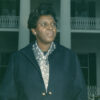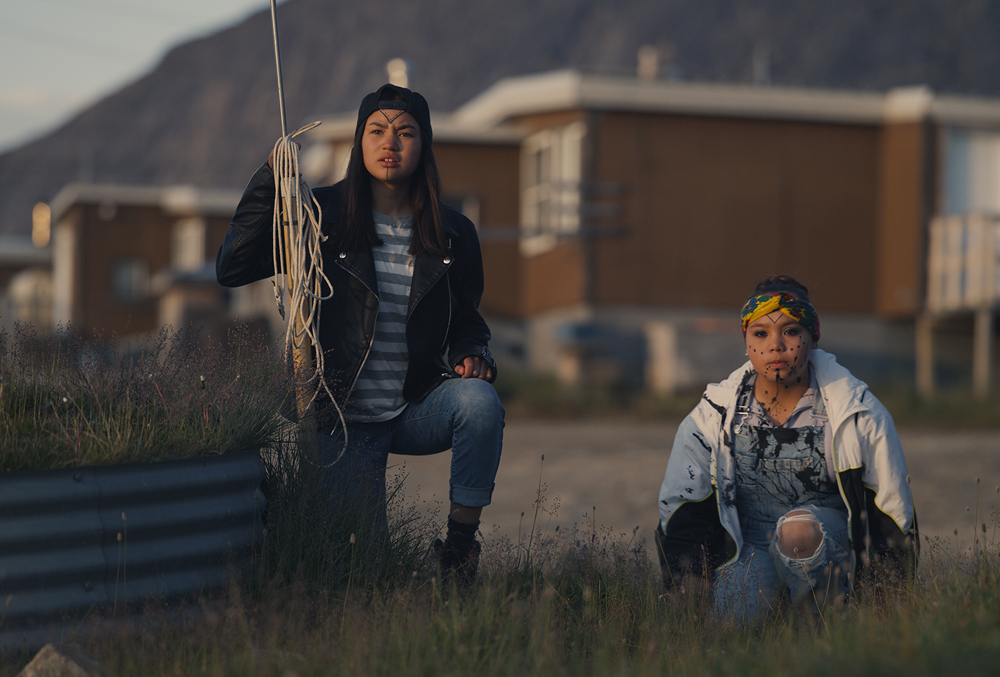“Can we just go back to hunting a blood-sucking alien?” Maika (Tasiana Shirley) asks innocently enough in “Slash/Back,” in which it can seem as if the octopus-like extraterrestrials that have come to invade Nunavut are the least of the issues in the Inuit community where a band of teenagers have trouble convincing their elders that there is a need to take up arms. It isn’t that their parents are resistant to a fight — Maika can be seen in the opening minutes of Nyla Innuksuk’s feature debut being taught to handle a rifle by her father — but the chasm that’s grown between generations when legends of old don’t seem to hold much import to the young and the old are content to abide by routine, holding a Solstice Dance while the aliens feast on increasingly bigger and more sophisticated mammals outside.
Left to their own devices – quite literally when Maika and friends Jesse (Alexis Wolfe) and Uki (Nalajoss Ellsworth) develop their own weaponry while Leena (Chelsea Prusky) senses nothing good comes from fighting – the kids demonstrate the power of not being beholden to the past while at the same time coming to respect the lessons it may have for them in inventive sci-fi action adventure, cleverly reflecting the history of the indigenous community that has endured far more than the cold, living on the edge of the arctic circle. Territorial encroachment has been seen before in Nunavut, but Innuksuk and co-writer Ryan Cavan envision it with an equally fresh perspective as their main characters, depicting the ripple effect a destabilizing force can have on a community, creating divisions not only across age lines but social strata.
One of the few things that doesn’t surprise in “Slash/Back” is how much there is to unpack when it may be Innuksuk’s first narrative feature, but she is able to draw on a wealth of work in various mediums from VR projects to documentaries to comic books. She would need to get creative in all aspects to pull off the production in the remote locale, converting a high school into a production center with beds shipped up far north for the crew while the young cast could provide inspiration from their real lives, living in the region. Now all are headed south to Austin for SXSW where the film will be making its triumphant premiere and just before her travels, the writer/director graciously took the time to talk about how “Slash/Back” came together, why the cast had no problem reacting with fear to the make-believe involved in an effects-heavy shoot and the benefits of a long development process.

I have always loved movies, and I love kids adventure action movies. Being from the Arctic in Nunavut, I thought that would be a great place to set a movie like this because growing up, especially in the summer with the 24 hour sunlight, you can get into so many adventures with your friends. The idea of getting to make a feature has always been a dream, but certainly, I’m like, “Oh, girls fighting aliens? I can see a video game there or an interactive thing.” I don’t think that by working in one it necessarily limits the others and all of my work cross-pollinates. I like to work and think about certain themes or ideas. Film is obviously a love of mine, but I also love interactive media, augmented reality, VR, and comic books, so these kinds of mediums give me an opportunity just to sit in spaces and think about things. Describing [“Slash/Back”], it’s like an action adventure kids horror movie…with an alien invasion, so for this one, I definitely drew a lot just from my love of movies.
How did you find your cast?
It was really a unique experience. I knew early on that I wouldn’t be able to just find a casting agent [when] there is no casting agencies in Nunavut and it was really important that all my actors be Inuit. I didn’t have a lot of money when I first started developing the project, so I was developed a proof of concept in order to get the feature made. I was doing some location scouting of Iqaluit, which is the capital city. It’s also where my parents lived, so I could just stay there and I worked with Christine Tutu, who ended up working in my props department, but she’s an actor from the Arctic who works in theater and has done some film and TV work. She helped me put on these acting workshops for youth. From there, we were using sides from the script for the proof of concept and I was just helping with the workshop, but then trying different girls in different combinations, so it wasn’t a formal casting, but through that, I found the majority of my cast.
Then it took a couple of years to actually get the movie made, so my cast changed [because] they were aging. Nalajoss, who ends up playing Uki actually was cast as the younger sister in the proof-of-concept – she was younger than the rest of the cast, she was 11 and the other girls were 14 – and I actually didn’t cast Nalajoss initially in this movie because I thought she had aged out. A couple of months before I was going to film, I ran into her at the grocery store and I was like, “You have grown up!” The role she would potentially be playing was going to be the most challenging, so it was a bit of a risk and she got the role really a week before we started filming. But in the end, I’m really glad that we were able to figure it out.
Once you see the dynamic with a group of actors like this and they maybe bring it to life in their own ways, was there anything you could get really excited about you may not have expected?
Yeah. A lot of the cast was involved very early on [from] this proof of concept, and I didn’t even have my producer team yet. Once we got some development funding and we were able to bring on Ryan Cavan, my co-writer, we spent some time in Nunavut together with these girls. They were taking us out on the boats and hanging out with us out on land and we lot a sense of their dynamics. Some of them knew each other [already] but we cast these girls together and they’re having to figure out who’s who, so we could just see the dynamics of teenagehood working. And it was just this reminder no matter what’s going on teenagers everywhere there’s some things that will just override everything, like friendships and boys. Even in an alien invasion, those things will still somehow find their way into life and that dynamic definitely played its way into the development of the script and their performance reflected that, because by that point they were all quite close friends and had been through so much together.
Part of that universality comes from the specificity of it and the generational tension that exists among old attitudes and young.
It’s probably true in a bunch of different communities, but certainly in the indigenous community and in the Arctic, there are these generational changes. The colonization of the Arctic happened quite late, so these changes have happened very recently. Loss of language is a big issue, and I know that growing up I certainly had shame that I carried in my indigenity and I could see that within the cast and within young people. Even within the language that they would use, like, “I don’t want to do that. That’s too Inno.” And it’s like, what does that mean? For me, I’m trying to figure out that [as a story] for Maika and her friends, they’ve got to realize that what they’ve got – this community that they’re from – is worth fighting for. They’re also these kids who are uniquely capable of hunting, and it’s great talking to the cast, they all know how to boat and some of them shoot rifles, some of them really don’t and would rather not. [laughs] But that was interesting – the Leena character who decides not to fight, there’s also those people too, who are like, “Yeah, not for me.”
So the theme of indigenity, [with] Maika’s character moving towards being prideful of herself and where she come from, was really important to me [because] it’s been really important to move from shame to pride in my indigenity. Even watching these young actors who are leading this film and the roles that they’re taking on as just promoting the movie or even just speaking to their role, it’s been wonderful for me to see.
This is a practical question, but even with a seasoned cast, you’re working with effects where it might be difficult to imagine what the final product will look like. What was it like getting something seamless from the set to the screen?
Some scenes were more challenging than the others. There’s a fox fight with Nalajoss and she was fighting with someone in a green screen suit wearing a puppet, so there’s that, but then there were also scenes where we had a contortionist wearing those skin suits. And some of our younger kids were really terrified of those creatures. One of my nephews is in the movie. He plays one of the brothers of Maika and he was really terrified of the monsters, so those kinds of things in some ways it made it easier because a lot of our effects are done practically.
What’s it like to have this under your belt?
I’m so happy to have the premiere at South By. They’ve got such a great tradition of horror and we shot the movie in 2019, so it’s been a minute. When I was making the movie, it was my first feature, so it’s like learning 50 lessons a day, but by the end, I was like, “Okay, now I know how to make a movie.” It really has been that energy that we can get this movie out, but I’m really happy and ready for what’s next.
“Slash/Back” will screen at SXSW on March 13th at 12:45 pm at the Alamo Lamar D, March 14th at 3:45 pm at the Violet Crown 1 and 4:15 pm at the Violet Crown 3 and March 17th at 6:15 pm at the Stateside Theatre. It will also screen virtually for SXSW Online badgeholders beginning March 14th-16th.




